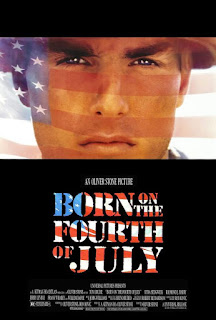Oliver Stone is a fascinating figure in the film world. He began as a screenwriter in the 70s and 80s and wrote successful scripts for Midnight Express, Scarface, Conan the Barbarian, and The Year of the Dragon. In the mid-eighties, he got his first directing gig with Salvador and then hit a hot streak with Platoon, Wall Street, Talk Radio, and Born on the Fourth of July. In many ways, his films are pure representations of 1980s culture. His preoccupation with the conflicts, music, and intrigue of the 1960s along with his sharp critiques of contemporary 1980s excess and consumerism made his films potent and memorable documents of the decade.
One film of his I hadn’t seen was 1989s Born on the Fourth
of July starring Tom Cruise. It’s based on the autobiography of the same name
by former Marine and disabled Viet Nam vet, Ron Kovic. Kovic is a gung-ho,
America-love-it-or-leave-it patriot who grows up in working class Long Island.
Relentlessly competitive, he volunteers for the Marines as soon as he’s
eligible and is sent overseas to fight. During his second tour in Viet Nam,
Kovic has a catastrophically bad day. All in one maneuver, he’s party to accidentally
killing a small village of old women, children, and babies; killing one of his
own men with friendly fire; and getting shot himself and having his spinal cord
severed with the bullet, permanently paralyzing him from the chest down.
The second two thirds of the movie revolve around Kovic
first fighting his disability, then succumbing to depression and bitterness and
alcoholism, and then finding new purpose as an anti-war activist, culminating
with the moment when Kovic addresses the 1976 Democratic National Convention
following the publication of his book.
Oliver Stone is not a restrained filmmaker. In fact, the
first movie review I read that ever really stuck with me as a kid was of Platoon and the reviewer wrote that
Stone “directs with all the subtlety of an earthquake.” And it’s true. He’s a
maximalist who layers on thick helpings of period music, extreme hair and
make-up, and sometimes far too close for comfort camera work. In the case of Born on the Fourth of July, his version
of late 1950s Long Island is as ideal and red, white, and blue as you can
imagine. His Viet Nam is saturated with sunlight and blood. The underfunded,
understaffed VA hospital where Kovic finds himself after his injury is
practically a Dantean circle of hell. I’m not saying these aren’t accurate
representations of Kovic’s real life experiences. It’s just that Stone’s middle
name might as well be “In Your Face.” Sometimes that intensity serves the story
and other times, it just makes you a little nauseated.
Born on the Fourth of
July was one of Tom Cruise’s first bids to be taken seriously as a “real”
actor instead of just a good looking kid with a megawatt smile. He hadn’t yet
developed the now tired Cruise-isms that have made so many of his recent
performances basically interchangeable, and he gives Kovic a real visceral
punch and vulnerability. With the exception of some pretty bad wigs, Cruise’s
transformation from 18 year old super jock to a middle aged man in a wheelchair
is convincing and his physical commitment to the role is apparent throughout.
The commitment paid off as Cruise was nominated for an Oscar and won the Golden
Globe that year for Best Actor. The film was nominated for a total of eight
Oscars and won two, including Best Director. Stone has produced a lot of
provocative, in-your-face films like Natural
Born Killers, JFK, and Nixon.
He’s still working today, and his most recent film was 2016’s Snowden. However effective his newer
films may be, it’s unlikely that Oliver Stone will ever hit another high point
like he did with his 80s hot streak that culminated with Born on the Fourth of July.


